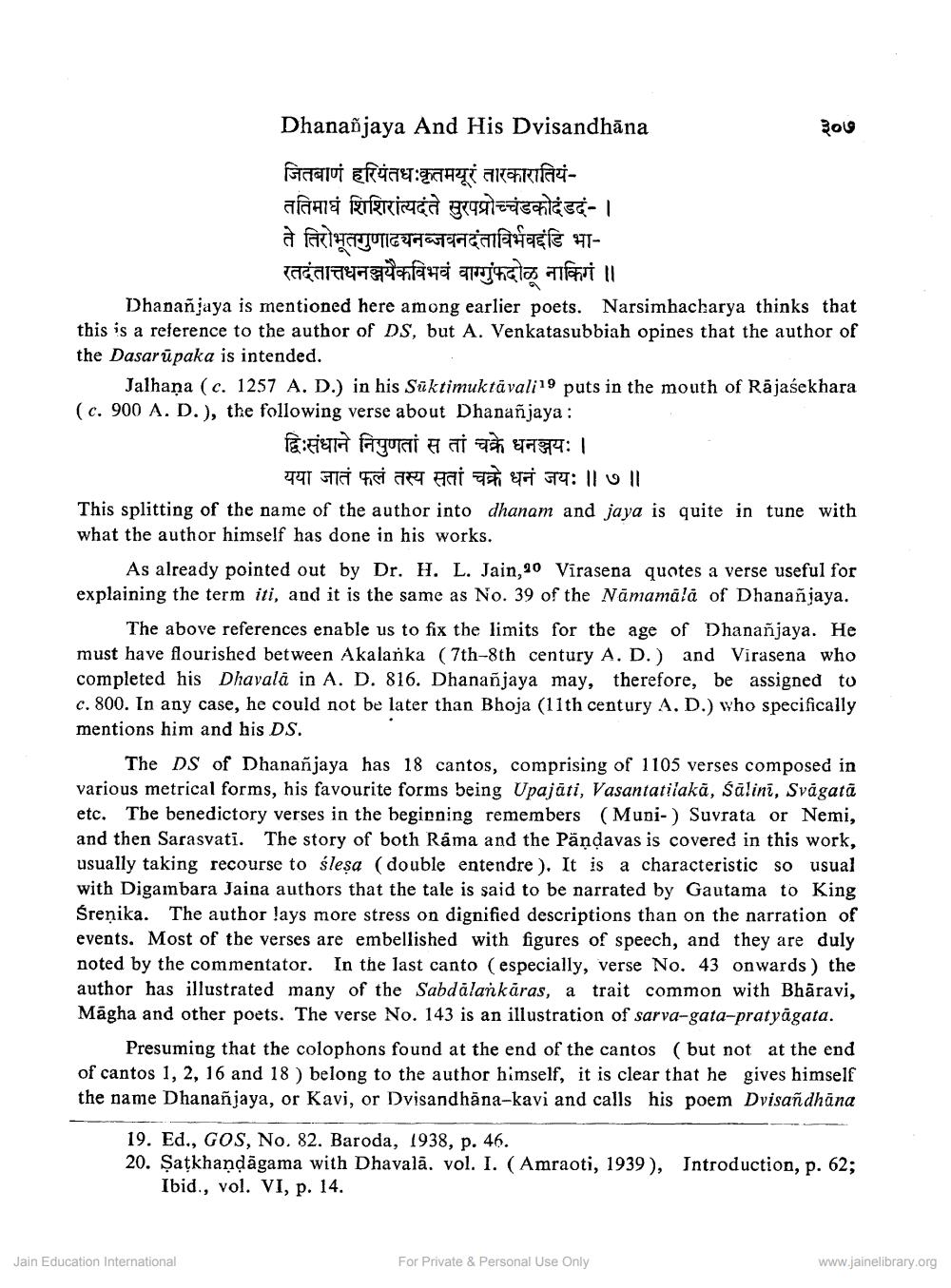Book Title: Dhananjaya and his Dwi Sadhana Author(s): A N Upadhye Publisher: Z_Acharya_Shantisagar_Janma_Shatabdi_Mahotsav_Smruti_Granth_012022.pdf View full book textPage 5
________________ Dhananjaya And His Dvisandhāna ३०७ जितबाणं हरियंतधःकृतमयूरं तारकारातियंततिमाघ शिशिरांत्यदंते सुरपप्रोच्चंडकोदंडदं-। ते तिरोभूतगुणाढयनब्जवनदंताविर्भवइंडि भा रतदंतात्तधनञ्जयैकविभवं वाग्गुंफदोळू नाकिगं ॥ Dhananjaya is mentioned here among earlier poets. Narsimhacharya thinks that this is a reference to the author of DS, but A. Venkatasubbiah opines that the author of the Dasarūpaka is intended. Jalhana (c. 1257 A. D.) in his Sūktimuktāvali19 puts in the mouth of Rajasekhara (c. 900 A. D.), the following verse about Dhananjaya : द्विःसंधाने निपुणतां स तां चक्रे धनञ्जयः । यया जातं फलं तस्य सतां चक्रे धनं जयः ॥ ७॥ This splitting of the name of the author into dhanam and jaya is quite in tune with what the author himself has done in his works. As already pointed out by Dr. H. L. Jain, 20 Virasena quotes a verse useful for explaining the term iti, and it is the same as No. 39 of the Nämamåla of Dhananjaya. The above references enable us to fix the limits for the age of Dhanañjaya. He must have flourished between Akalanka (7th-8th century A. D.) and Virasena who completed his Dhavala in A. D. 816. Dhananjaya may, therefore, be assigned to c. 800. In any case, he could not be later than Bhoja (11th century A. D.) who specifically mentions him and his DS. The DS of Dhananjaya has 18 cantos, comprising of 1105 verses composed in various metrical forms, his favourite forms being Upajāti, Vasantatilakā, sālini, Svägata etc. The benedictory verses in the beginning remembers (Muni-) Suvrata or Nemi, and then Sarasvati. The story of both Rāma and the Pandavas is covered in this work, usually taking recourse to ślesa (double entendre ). It is a characteristic so usual with Digambara Jaina authors that the tale is said to be narrated by Gautama to King Śreņika. The author !ays more stress on dignified descriptions than on the narration of events. Most of the verses are embellished with figures of speech, and they are duly noted by the commentator. In the last canto (especially, verse No. 43 onwards) the author has illustrated many of the Sabdalaňkāras, a trait common with Bhāravi, Māgha and other poets. The verse No. 143 is an illustration of sarva-gata-pratyāgata. Presuming that the colophons found at the end of the cantos (but not at the end of cantos 1, 2, 16 and 18 ) belong to the author himself, it is clear that he gives himself the name Dhananjaya, or Kavi, or Dvisandhāna-kavi and calls his poem Dvisañdhāna 19. Ed., GOS, No. 82. Baroda, 1938, p. 46. 20. Şatkhandägama with Dhavalā. vol. I. (Amraoti, 1939), Introduction, p. 62; Ibid., vol. VI, p. 14. Jain Education International For Private & Personal Use Only www.jainelibrary.orgPage Navigation
1 ... 3 4 5 6 7 8
